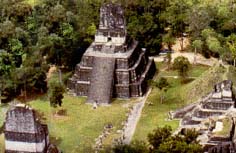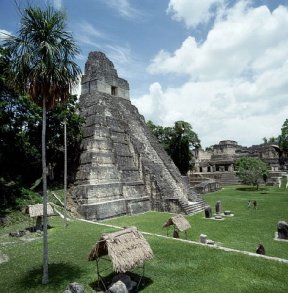
|

|
|
Tikal was a major city of the Maya. At least 10,000 people lived within its six square miles. The maps show 3000 temples, palaces, shrines, ceremonial platforms, residences, ball courts, terraces and plazas. Tikal is located in the middle of Tikal National Park, a wildlife preserve covering 222 square miles and the first park of its kind in Central America. |
 |
|
The park is a magnificent jungle and wildlife preserve. Some of the rainforest trees that grow in the park are Spanish cedar, ceiba, a tree sacred to the Maya, zapotes, mahogany and chicle, which is an ingredient in chewing gum. |
|
|
Living among the ruins are groups of spider monkeys, hundreds of species of birds, including hawks, hummingbirds, parrots, and golden turkeys. Nearby are jaguar, puma, ocelot, pecarry, small deer, and many other animals, some of which are endangered. In the main ceremonial area there are 200 stone monuments, known as stelae. Stelae were elaborately carved with glyphs, a form of writing, and other images. Stelae were mostly carved in southern portion of Maya lands especially around Tikal. |
 |
|
Nearly 100,000 tools, ceremonial objects, personal ornaments, and other items
have been discovered. They tell many stories about the daily Maya life.
Their ceramics were especially beautiful.
Smaller homes were arranged in clusters around
a central plaza. Most people were buried beneath the houses they
had lived in. Along with the bodies were ritual objects that seemed
to have daily life uses as well. One temple is called the Giant Jaguar. Built in AD 870, it towers 145 feet above the Great Plaza. Many tombs are beneath and inside the structure. Other groups are called the Lost World Complex, the Plaza of the Seven Temples, the Twin Pyramid Complex, and the Acropolis. |
|






